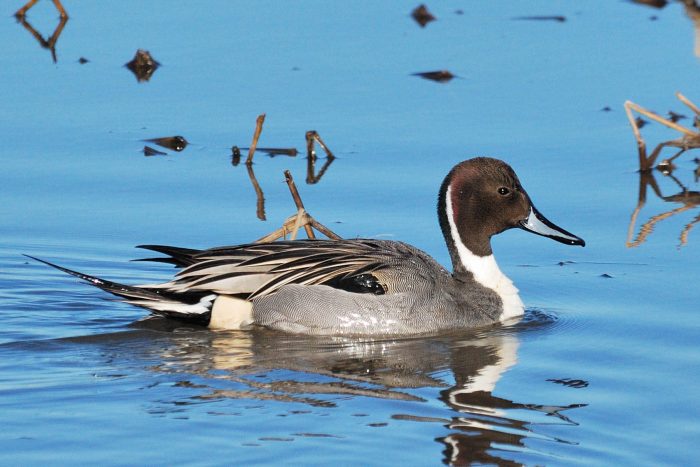Northern Pintail
Anas acuta
The northern pintail is a dabbling duck with long, pointed tail feathers. It visits fresh and brackish tidalmarshes and rivers throughout the Chesapeake Bay region from autumn through spring.
This section shows one large critter image at a time. Use the thumbnails that follow to select a specific image to display here.

This gallery contains a grid of small thumbnails. Selecting a thumbnail will change the main image in the preceding section.
Appearance
The northern pintail is named for its long, pointed tail feathers. The female's tail is much shorter than the male's needle-like tail. Males and females have different patterns and coloring. Males have a dark brown head, a white neck and breast, and a grayish back. A finger-like white stripe extends from the neck into the brown part of the side of the head. Females are mottled brown all over with a tan head and neck. Males and females both have brown wing patches (called specula) with a white border on one side. Pintails have long, slender necks and grayish bills. They grow to about 26 to 30 inches in length with a wingspan of about 35 inches.
Feeding
These ducks eat mostly seeds from bay grasses and aquatic plants, but will also eat small insects and crustaceans as well as grains and seeds from farms and fields. They feed at the water’s surface or by “tipping up” their tails and submerging heads to reach food underwater.
Predators
Humans are pintails’ greatest predator. Bobcats and coyotes prey upon adult pintails, while gulls, foxes and raccoons eat eggs and young.
Flight
The pintail takes off by jumping straight from the water. It can be identified in flight by its long, pointed tail feathers.
Voice
The male’s call is a soft, double-toned whistle that sounds like kwee-hee. Females make a low, hoarse quack.
Reproduction and life cycle
Pintails do not nest and breed in the Bay region, instead nesting throughout the central continental United States, as well as in Canada and Alaska. They can live as long as 22 years in the wild.
Did you know?
- The northern pintail gets its name from its long, pin-like tail. It is also known as a sprig, short for "sprig-tail."
- It has the largest breeding range of any duck in North America and can migrate very long distances in relatively short periods of time. A northern pintail was once banded in Labrador, Canada, and shot by a hunter in England nine days later.
Sources and additional information
- Life in the Chesapeake Bay by Alice Jane Lippson and Robert L. Lippson
- Chesapeake Bay: Nature of the Estuary, A Field Guide by Christopher P. White
- Animal Diversity Web: Anas acuta – University of Michigan Museum of Zoology
- Waterfowl ID: Northern Pintail – Ducks Unlimited
- NatureWorks: Northern Pintail – New Hampshire Public Television
